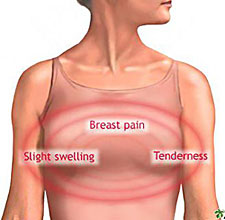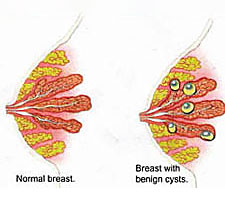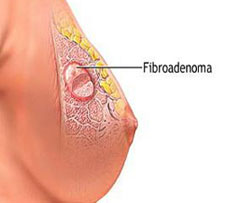Know what is normal for your breasts
Benign Breast Conditions & High Risk Lesions
Benign breast disease is used to describe many noncancerous disorders that can affect the breast.
The term fibrocystic change may be used to describe a range of benign breast conditions.
Fibrocystic Breasts
Fibrocystic breast is a common occurrence. This may also be called fibrocystic breast disease. This is a condition, not a disease. Patients may experience breast pain, tenderness, and lumpiness, especially around their menstrual periods. More than half of women experience fibrocystic breast changes at some point in their life


Breast Cysts
Breast cysts are fluid filled sacs that can be a part of fibrocystic disease. They are common in pre-menopausal women. They may feel like a soft grape and can be tender especially around menstrual cycles. These are benign. Treatment is not necessary unless they are painful or cause discomfort. Treatment consists of draining the fluid from the cyst.
Fibroadenoma
Fibroadenomas are solid, benign tumors that are common in young women. These are generally painless, mobile, and rubbery. They may enlarge around pregnancy and breast feeding. Treatment may include careful monitoring to detect changes in the size or feel, or surgery to remove it.

Intra-Ductal Papilloma
Small growths in the milk ducts that may cause nipple discharge. Surgery is performed to remove. There is no increased risk of breast cancer with papilloma. No treatment is required after surgery if no cancer or atypical cells are found in association with the papilloma.
Radial Scars
Complex cores of connective tissue that appear suspicious on mammogram. Usually found on biopsy. Not cancer and no treatment necessary after removal. Studies are mixed in deciding if they are associated with an increase in breast cancer. Radial scars may be found in association with other breast conditions.
HIGH RISK LESIONS
Flat epithelial atypia
Flat epithelial atypia is NOT cancer. if this is found on a core biopsy your doctor may recommend an open excision because sometimes it can be found near something more serious. If this was found on an open biopsy ( surgical excision) you may not need any additional surgical treatment.
Lobular Carinoma In-Situ (LCIS)
LCIS is not cancer but about 25 percent of women with LCIS will develop breast cancer at some point in their lifetime. If this is found on a core biopsy, your doctor may recommend an open surgical excision.
Atypical ductal hyperplasia
Atypical ductal hyperplasia (ADH) is also not breast cancer, but serves as a ‘marker’ for the future development of breast cancer. Again, if this is found on a core breast biopsy, your doctor may recommend an open surgical excision.
The treatment of the above high risk lesions are ever-changing. Always talk to you doctor for the proper treatment. Some physicians will decide to put you on Tamoxifen to lower your risk for the future development of breast cancer.

